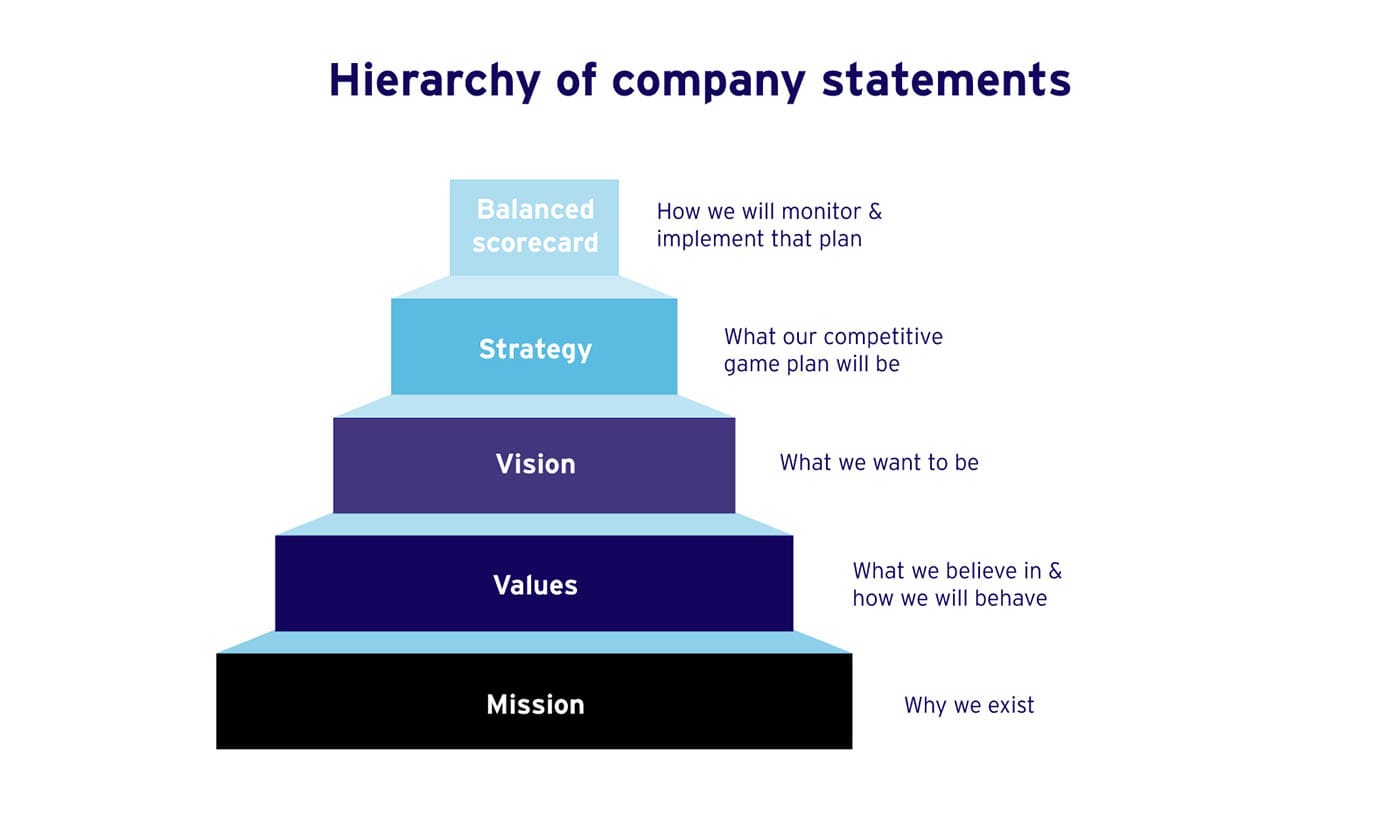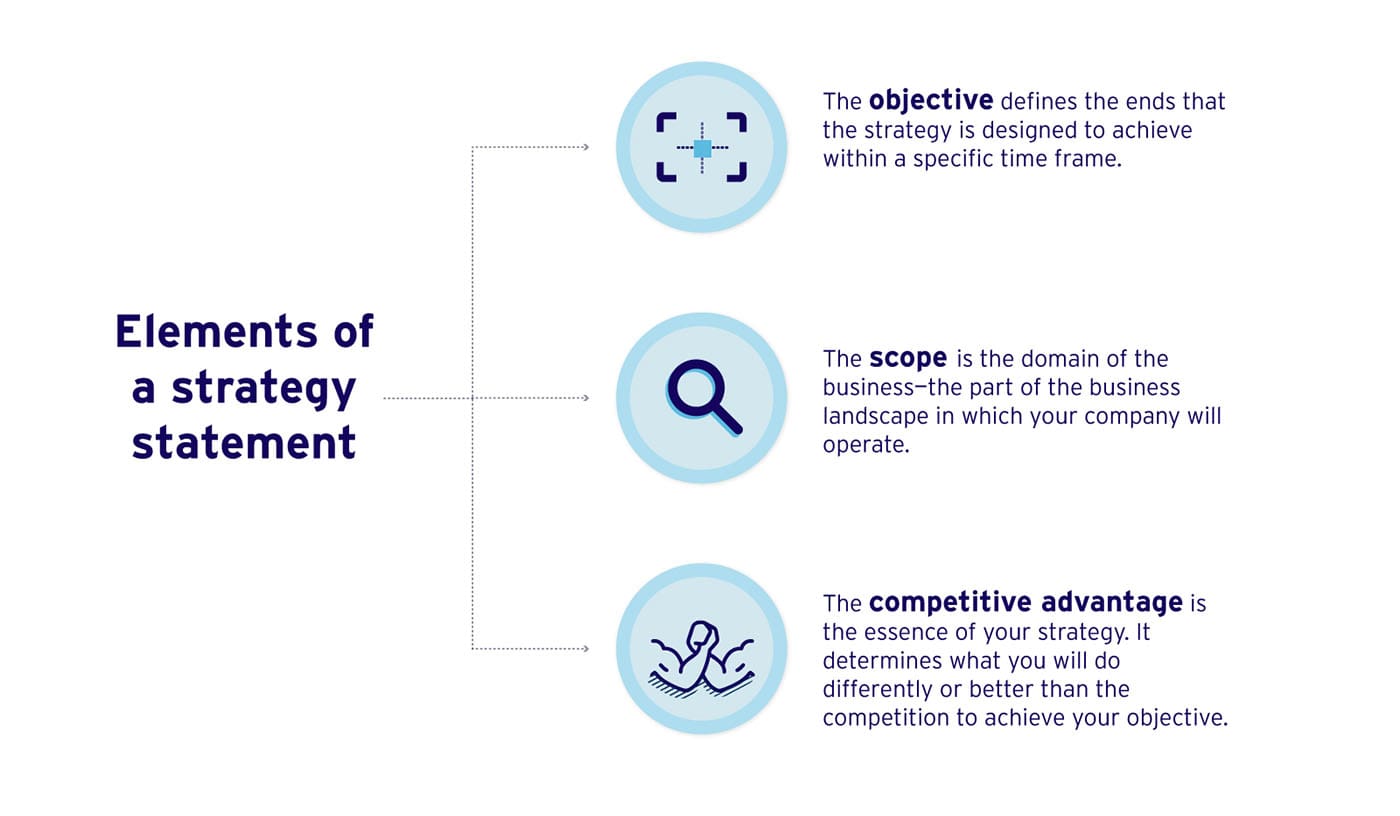Strategy statement: Articulating your competitive advantage, objectives and scope
Read time: 4 mins
Read the highlights
A strategy statement communicates your company’s strategy to everyone within your startup. The statement consists of three components: objective, scope and competitive advantage. All three components must be expressed as clearly as possible.
A well-written strategy statement will help employees and the organization to understand their roles when executing the company’s strategy. Without this understanding, your startup may be pulled in different directions and lose its focus. The purpose of the strategy statement is to ensure that employees have a clear understanding of the company’s strategy.
Hierarchy of company statements
The strategy statement is the fourth level in the hierarchy of company statements. It is more concrete, practical, and unique than the mission statement.


Elements of a strategy statement
There are three basic elements of a strategy statement: the objective, the scope and the competitive advantage.


Defining the objective, scope and competitive advantage requires trade-offs, which are fundamental to strategy. For example, if a company decides to pursue growth, it must accept that profitability will not be a priority. If it decides to serve institutional clients, it may ignore retail customers.
Defining the strategic objective
The strategic objective is the single, specific objective that will drive the business over the next few years. It is based on the maxim, “If you don’t know where you are going, any road will get you there.” It is not to be confused with the company’s mission, vision or values, which are not useful as strategic goals. The objective must be specific, measurable and time bound. It must also be a single goal (that is, growth or profitability), although subordinate goals may follow from the strategic objective.
Maximizing shareholder value is one strategic objective. However, many strategies are designed to achieve this goal. When creating a strategy statement, you must answer the question: Which objective is most likely to maximize shareholder value over the next few years?
For early-stage startups, the objectives relating to your market strategy depend on the type of market you plan to enter.
Entering an existing market
If you enter an existing market, your aim for the first year will be to maximize the market share that you capture from the competition. To measure that objective, you need to:
- Determine the revenue associated with your desired market share
- Break it down by number of orders
- Then reverse engineer the rest of your sales funnel to calculate how many leads, prospects and proposals would be associated with your revenue target
Entering a new market
If you enter a new market, your first-year objectives will differ. They will not be revenue-oriented. Instead your objectives will focus on:
- Educating potential customers about your vision (by demonstrating thought leadership about their having a business problem and your solution to fix it)
- Turning these early adopters (“visionaries”) into reference customers
At the end of the year, ideally you will see evidence of traction around your vision:
- Invitations to speak at conferences
- Mentions by one or two key opinion leaders
- Increased website traffic
- Increased inquiries from potential customers.
The details will depend on the nature of your business, but in general, these types of measures will indicate whether a market exists for you.
Defining the scope
The company’s scope encompasses three dimensions—the target customer or offering, geographic location, and vertical integration (that is, whole product). Each dimension may vary in relevance (for example, the customer may be more important than geographic location). Clearly defining the boundaries in each area should make it obvious which activities to concentrate on (and which ones to avoid).
The company’s scope does not determine exactly what should be done within those boundaries, as there is room for experimentation and initiative. However, it should specify where the company or business will not go. This will prevent employees from wasting resources on projects that do not fit the corporate strategy.
Defining the competitive advantage
The competitive advantage is the most important part of the strategy statement. It describes the logic of why you will succeed, how you differ, or what you are doing better than the competition. To define the competitive advantage:
- State the customer value proposition. Explain why customers should buy your product or service. Map your value proposition against those of your competitors to identify what makes yours distinctive.
- Outline the unique activities, or complex combination of activities, that allow your company to deliver your customer value proposition. In their book The Discipline of Market Leaders (1995), Michael Treacy and Fred Wiersma describe three generic value disciplines: operational excellence, customer intimacy and product leadership, with each value discipline reflecting the unique activities that provide a competitive edge. For more information, see the article Competitive strategies: Value disciplines.
- Create a business model canvas which connects the activities that deliver your company’s competitive advantage to your customer value proposition.
Developing a strategy statement
First, create a great product strategy based on careful evaluation of the industry landscape. Then, develop a strategy statement that captures the strategy’s essence in a way that makes sense to everyone at the company.
The process should involve employees in all parts of the company and at all levels. Work through the wording of the strategy statement in as much detail as possible.
The end result is a brief statement that reflects the three elements of an effective strategy and makes sense to everyone in the company. It may include explanatory notes to clarify issues and implications.
Summary: A strategy statement communicates three key aspects of your business (objective, scope and competitive advantage) to your employees to help them best execute their roles; without such clarity, your startup may lose its focus.
Read next: A strategy canvas: A tool for developing a differentiation strategy for technology products
Building your go-to-market strategy for an international market? Sign up to the International Growth Collection to access specialized resources built in partnership with Export Development Canada.

